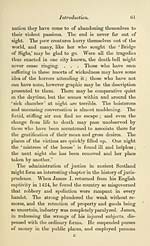Grampian Club > Scotland, social and domestic
(68) Page 62
Download files
Complete book:
Individual page:
Thumbnail gallery: Grid view | List view

62 Introduction.
to keep guard in their vicinity. When a purse was
taken down, the thief was suspended in its place.
The executioners of the law proceeded everywhere
gibbeting sturdy marauders, highway robbers, and
notorious thieves. These active measures produced a
restoration of civil order, and afforded security to
property ; and it can hardly be doubted that if the
life of the monarch had been prolonged, he would
have effectually stemmed that torrent of vagabondism
which, owing to his early death, continued to devastate
the kingdom. The short lives of the three succeeding
sovereigns prevented their materially aiding in the
suppression of felony. But the youthful James V., as
soon as he had attained freedom of action, raised a
powerful force of cavalry, at the head of which he
proceeded to the border counties to seek the extermi-
nation of those who subsisted by plunder. He was on
the borders with his mounted followers in June, 1529 ;
he then apprehended and hanged forty-eight notable
thieves, including their leader, the celebrated Johnnie
Armstrong.
When the sovereign was required siunmarily to
interfere in the punishment of crime, it may be con-
cluded that judicial arrangements were incomplete.
The precise character of ancient Scottish judicatories
has not been ascertained. There were three chief
justiciars. These are mentioned in chartularies so
early as the twelfth century. They possessed both civil
and criminal jurisdiction. There were likewise inferior
justiciaries, whose appointments were hereditary. The
office of sheriff, which is of great antiquity, was attended
with considerable authority. The Court of Session,
with its fifteen judges, was instituted by James V.
to keep guard in their vicinity. When a purse was
taken down, the thief was suspended in its place.
The executioners of the law proceeded everywhere
gibbeting sturdy marauders, highway robbers, and
notorious thieves. These active measures produced a
restoration of civil order, and afforded security to
property ; and it can hardly be doubted that if the
life of the monarch had been prolonged, he would
have effectually stemmed that torrent of vagabondism
which, owing to his early death, continued to devastate
the kingdom. The short lives of the three succeeding
sovereigns prevented their materially aiding in the
suppression of felony. But the youthful James V., as
soon as he had attained freedom of action, raised a
powerful force of cavalry, at the head of which he
proceeded to the border counties to seek the extermi-
nation of those who subsisted by plunder. He was on
the borders with his mounted followers in June, 1529 ;
he then apprehended and hanged forty-eight notable
thieves, including their leader, the celebrated Johnnie
Armstrong.
When the sovereign was required siunmarily to
interfere in the punishment of crime, it may be con-
cluded that judicial arrangements were incomplete.
The precise character of ancient Scottish judicatories
has not been ascertained. There were three chief
justiciars. These are mentioned in chartularies so
early as the twelfth century. They possessed both civil
and criminal jurisdiction. There were likewise inferior
justiciaries, whose appointments were hereditary. The
office of sheriff, which is of great antiquity, was attended
with considerable authority. The Court of Session,
with its fifteen judges, was instituted by James V.
Set display mode to: Large image | Transcription
Images and transcriptions on this page, including medium image downloads, may be used under the Creative Commons Attribution 4.0 International Licence unless otherwise stated. ![]()
| Publications by Scottish clubs > Grampian Club > Scotland, social and domestic > (68) Page 62 |
|---|
| Permanent URL | https://digital.nls.uk/81897500 |
|---|
| Description | Note: Numbers 24-41 are relative to but not part of the Club's series. |
|---|---|

